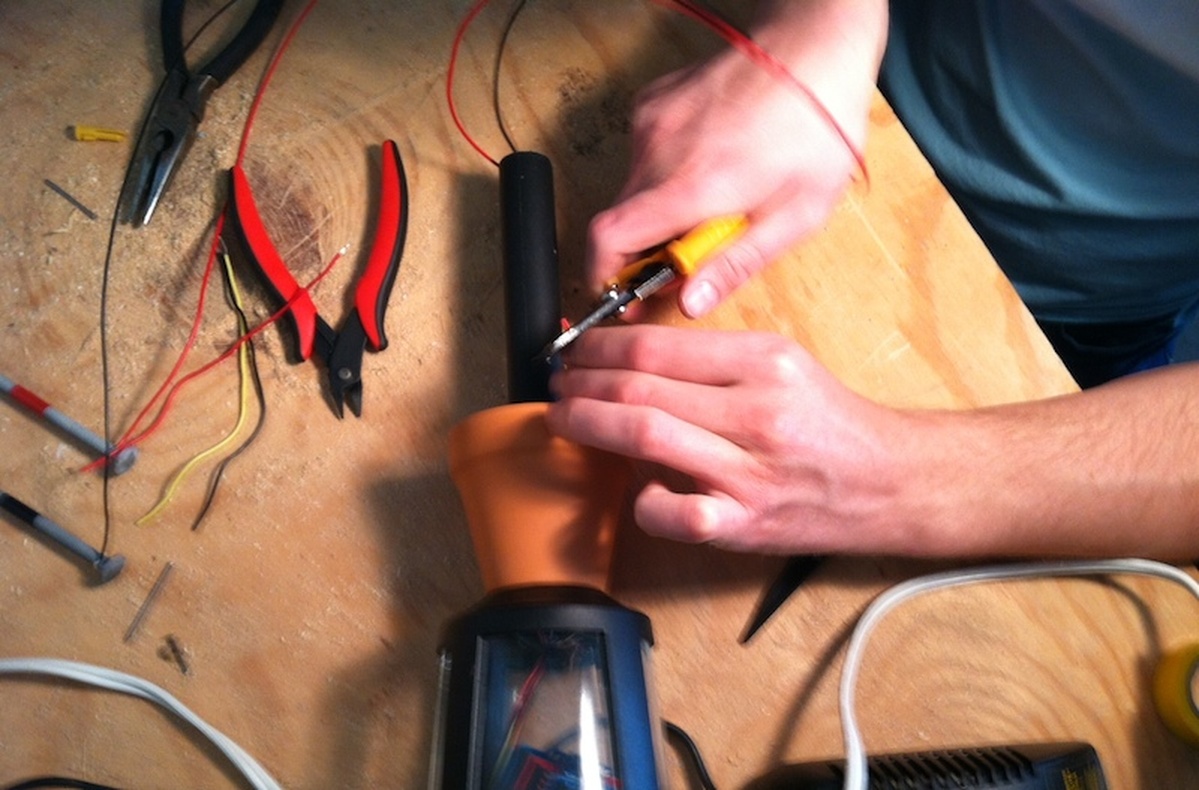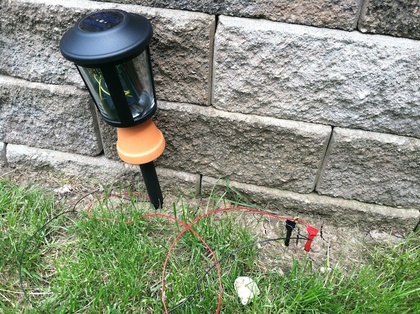Features:
Slouching Toward Sensor Journalism
Matt Waite on the making of a drought sensor—and why sensors matter

The drought sensor in progress (Matt Waite)
Standing in the food storage aisle arguing if an oven safe resealable bowl is a better sensor storage unit than a solar-powered sidewalk light has to go down as one of the strangest journalism moments of my career. But there we were, Ben Kreimer and I, having this argument. Other shoppers must have thought we were crazy.
We’d already discarded gourmet gelato containers and neither of us wanted to eat a jar of peanut butter, so it was down to two. And it was just another debate on the road to a prototype personalized drought monitor—a wireless data collection device that would tell us the temperature, relative humidity, and soil moisture content of a given spot.
Wait, journalists building devices? Yep. And I think you’re going to see more of it.
The problem with most news apps and data journalism is that they rely on the government to produce the data. If the government keeps numbers and you can pry it loose, game on. But what happens when the government doesn’t keep the data? Or you have a reason to believe it’s fatally flawed? Or what if you just want more?
When faced with this problem, most journalists will shrug their shoulders and give up. No data, no story, right? There are examples of journalists developing their own data, but few of them do it on a large scale.
Sensors open up a whole new world of data to journalists—data they themselves collect. That idea has both mundane and profound impacts. Journalists building their own devices means they’re taking a giant leap up in authority—from the device’s construction and capabilities to the data itself. There’s no source to call about the data because you are the source. And, you decide the scale of your data.
Scale is an interesting term here. Sensors open up a lot of dimensions of scale—geographic and temporal to name two. But there’re two others I think are far more important to consider if this is going to work: personal and communal.
Personal Scale
Editors everywhere are interested in the weather. More than 10 years and a few jobs ago, mine was no different, but he had a different take on it. His view of the weather could be explained as a basic algorithm: Is it raining on my yard? If it is, I care. If it is not, I do not care.
I chuckled at it at the time, but the more I think about it, the more I realize he’s right. People care about the weather where they are. Is my garden getting sunshine or rain? I want to know. Next neighborhood over? Don’t care. Potholes are another example. Pothole on my commute? I care deeply. Pothole one block off my commute? I could not possibly care less.
We can sit here and cry about this selfishness that’s in us all in some ways, or we can harness it.
What if we built a sensor that told someone something about where they are—personal to them—and gave them that data. The deal is, they get personal data if they host a device and agree to contribute to the greater whole. Which, speaking of that…
Communal Scale

A sensor in in action (Matt Waite)
One person’s selfish interest isn’t that interesting, but get a few hundred or a few thousand and suddenly you’ve got a fantastic picture of a thing. We do this now in all kinds of ways: Facebook can tell you all kinds of things about what people like; analyzing Twitter gives us a view of what those users are talking about; fitness apps give us a clear view of how motivated people are exercising. But it goes even further—analyzing traffic volumes gives us an indirect measure of how people get places and on what roads and when.
So what sensors for journalism can do is indulge people on that personal interest, while feeding that data into a communal data feed that enlightens us all. We get to be selfish and generous all at the same time.
This balance of selfish and magnanimous is the social contract I think will make this work: I’ll give you a device that’ll tell you something about your life if you agree to host it and contribute that data back.
Scaling to Measure Drought

Cobbling it together (Matt Waite)
For about three weeks, we’ve worked on a prototype at the College of Journalism and Mass Communications at the University of Nebraska-Lincoln. We started with a simple question: How can we make drought a personal story?
A little background for you: Last year, Nebraska had one of the driest years on record. We had the smallest mount of rainfall since the Dust Bowl drought of the Great Depression. That drought was a calamity that wiped out farms and farmers across the Midwest. There was no such financial catastrophe this time, but it was an alarmingly bad year for the state’s main economic engine and the environment.
And it’s a tough story to tell. There’s all kinds of numbers, maps, and pictures of dried up creeks and dead lawns—we even used a drone to get video of a river with barely any water in it. But it all feels so big that it’s hard to break it down to something people connect with.
Could we build a sensor that let people know exactly how dry it was where they lived?
We thought we could, so we set out to build it. Through a long process of trial and error, this is what we have:
- An Arduino microcontroller to act as the brains of the operation.
- A WiFi card to push data to the cloud.
- A temperature and relative humidity sensor capable of measuring those values every 250 milliseconds (if we wanted to).
- A DIY soil moisture sensor, which consists of two 16d galvanized nails pushed into the ground.
Wait, nails in the ground? Yeah. Really. It works. Here’s how: When we run a current over it, it tells us how much resistance there is in the soil. Wet soil conducts electricity better than dry soil. Through the miracles of linear algebra and the point-slope form of a line, we can determine how saturated the soil is as a percentage.

The sensor’s innards (Matt Waite)
Arduino makes this kind of prototyping really simple. It really is just following instructions and hacking other people’s code together to do what you want. Arduino’s language is based on C/C++, but if you know any programming at all, you can follow along and hack stuff together. So step one is usually finding what someone else has done and trying to bend it to your will. For this, we found that Arduino already has a digital temperature and humidity library, and another developer built a soil moisture sensor out of some wire and a better understanding of electricity than we have. The trick then was sending those values over WiFi to a cloud data store. After a lot of trial and error, we had data streaming out every 10 minutes.
Since we were shamelessly borrowing code generously given freely by others, we’ve put all our Arduino projects—in various forms of disaster, warts and all—on GitHub for anyone to see, fork, use, whatever. We’ve tried to document our Drought Monitor pretty thoroughly, including our first schematic drawn in a free program called Fritzing. If you’re wanting to make one yourself, most everything you need is there.
What Happened Next
After we got the boards built and the software worked out, we realized we had a whole new set of problems: We had to figure out how to put it outside. That’s when the Epic Debate In The Food Storage Aisle happened. We needed the housing to be nominally water tight, but where we could drill holes in it to get wires and the temperature sensor outside it. We wanted it to be more than a little durable, and we needed it to be cheap. We settled on an $8 sidewalk light, the ones you see with an LED in it and a solar panel on top. Yes, solar on top—could we use it to power our device? (Answer: we’re still not sure. We could extend the battery life a few hours, but we think we can do better.)
What happened during our field testing is a lesson in the cruelty of the Gods: After getting just 9.5 inches of rain in all of 2012, we got 4.5 inches of rain in one week. The week we deployed. The sensor worked, but the ground remained saturated the whole time. I think the lowest reading on soil moisture we got was 97 percent. With so much standing water in my yard, it might as well have been a flood monitor.
In spite of the challenges, I think this is a rich area for journalists and developers to mine. DIY Data Gathering Devices. Our own little data bots. Open hardware and the maker movement are making all kinds of tools and methods available to anyone who is willing to try, and data journalists should take note.
We’re within sight of augmenting reporters with a kind of robotic appendage—a data gathering network of sensors, letting us know when news is happening.
Matt Waite and John Keefe talking sensor journalism at Columbia. Worth watching in HD.
People
Credits
-
 Matt Waite
Matt Waite
Matt Waite is a professor of practice in the College of Journalism and Mass Communications at the University of Nebraska-Lincoln and founder of the Drone Journalism Lab. Since he joined the faculty in 2011, he and his students have used drones to report news in six countries on three continents. From 2007-2011, he was a programmer/journalist for the St. Petersburg Times where he developed the Pulitzer Prize-winning website PolitiFact.



